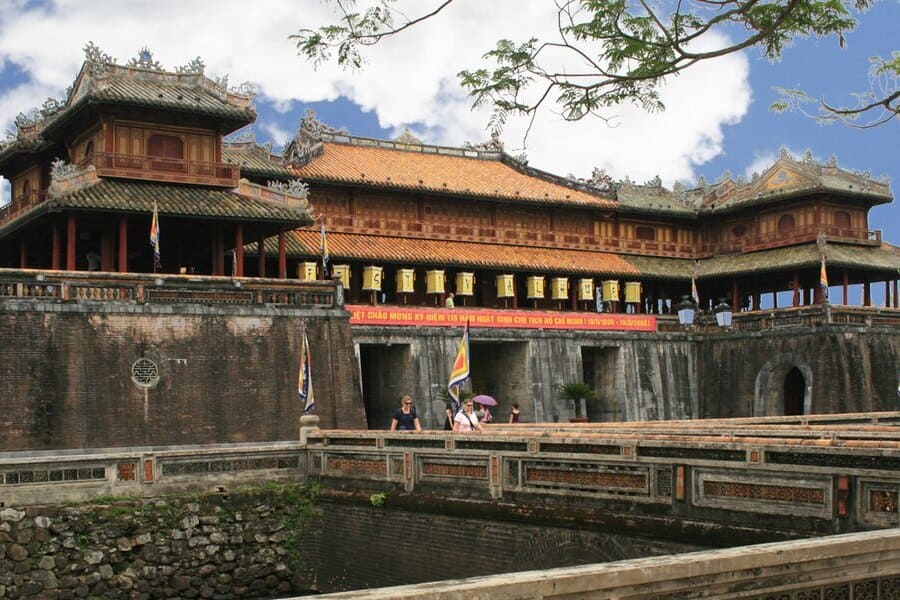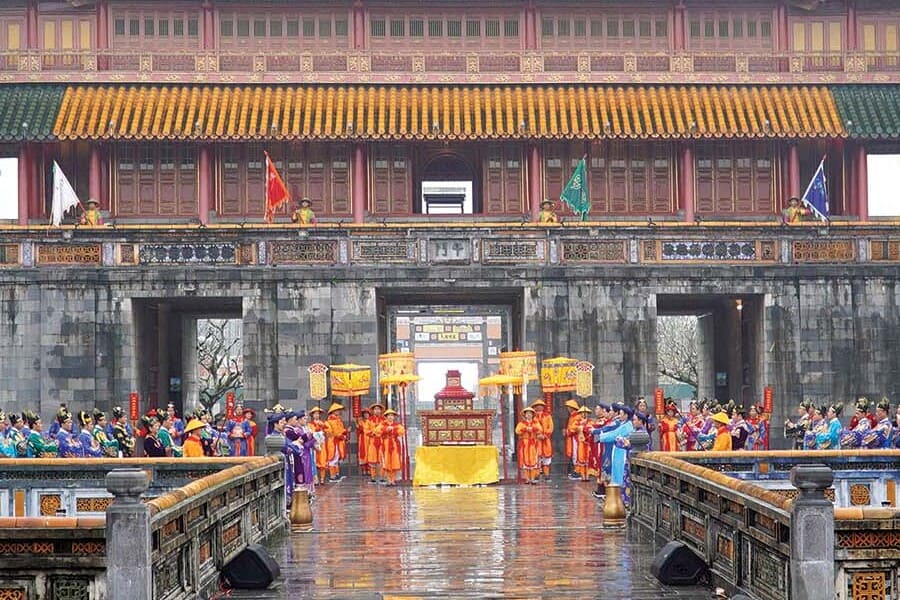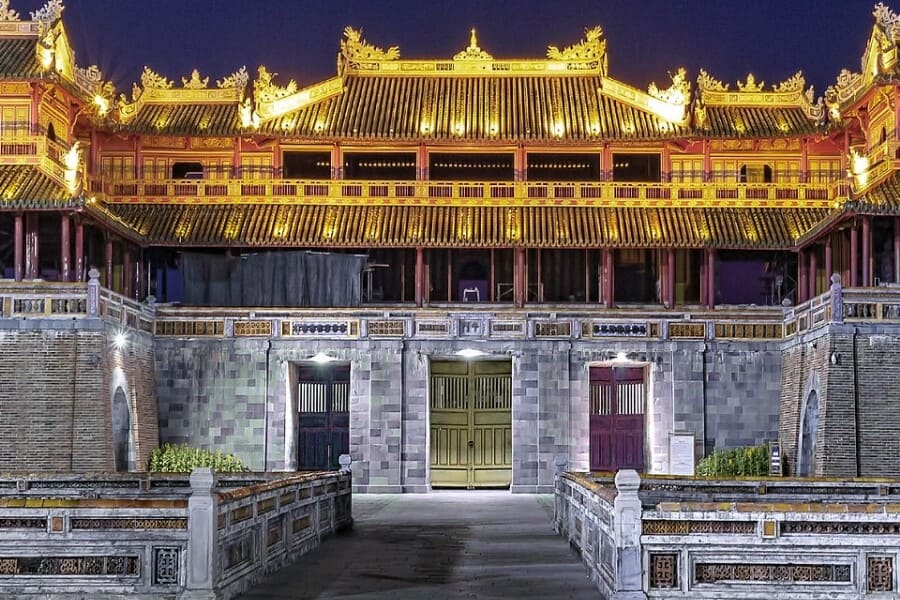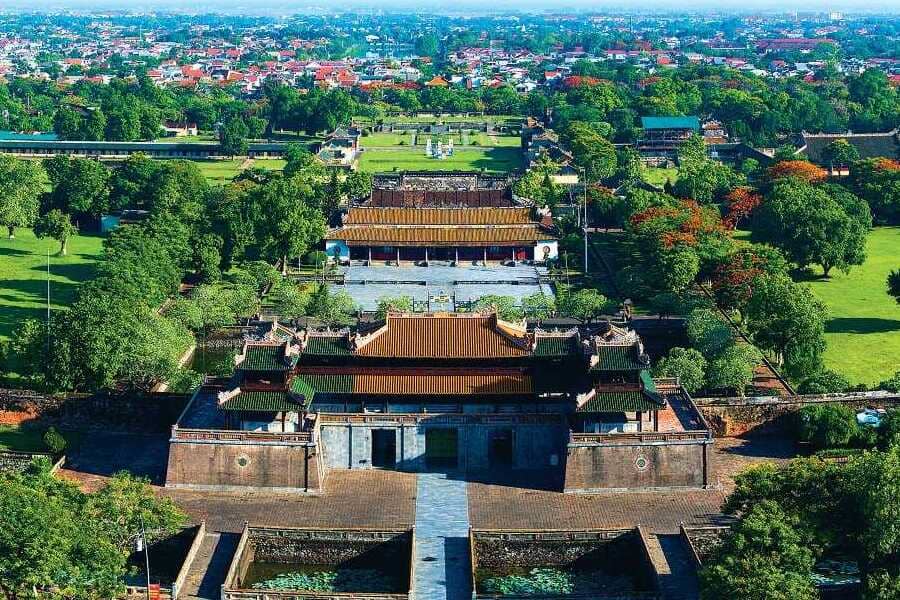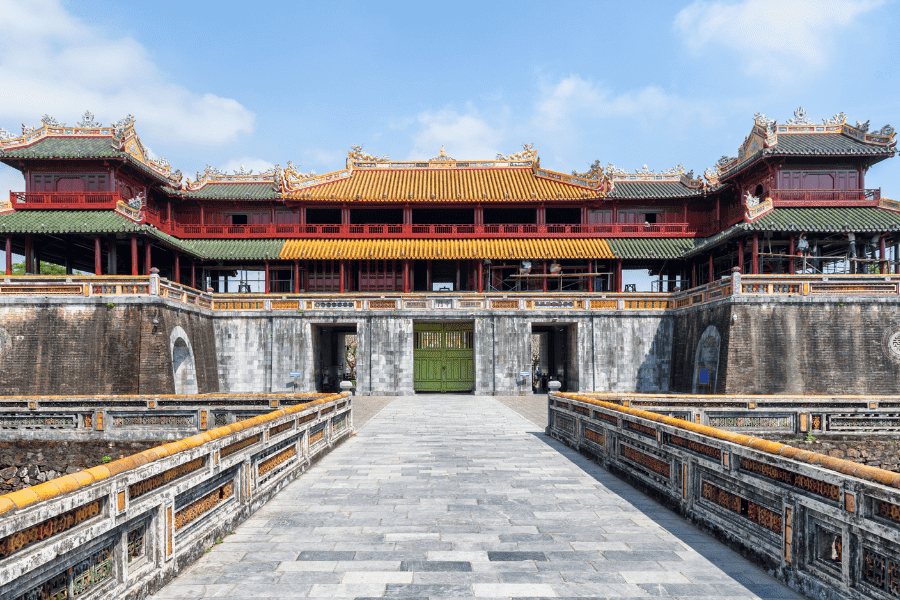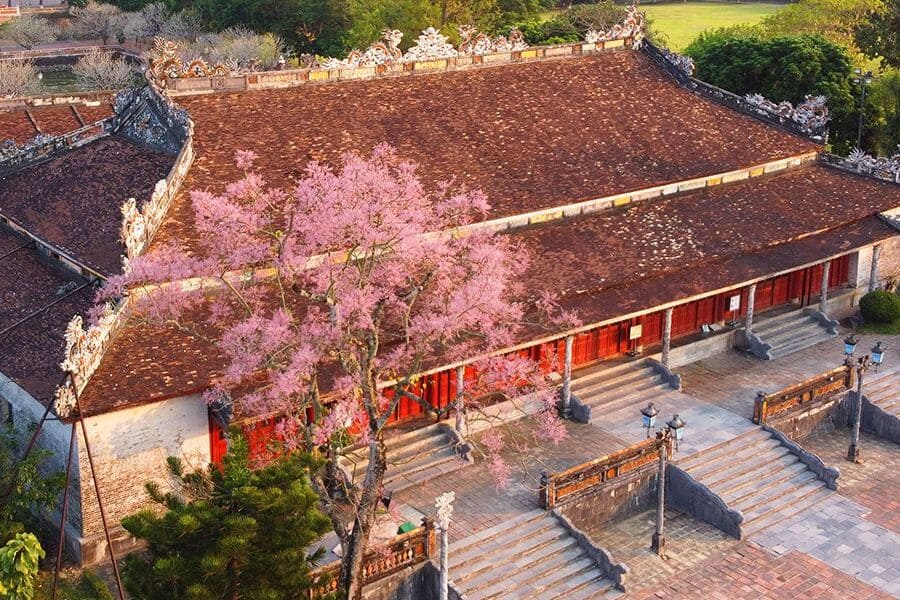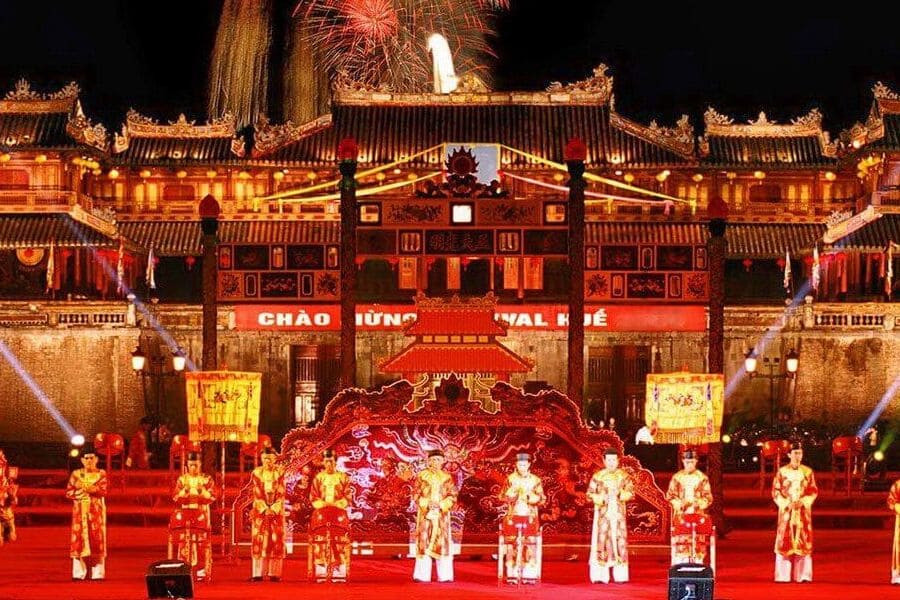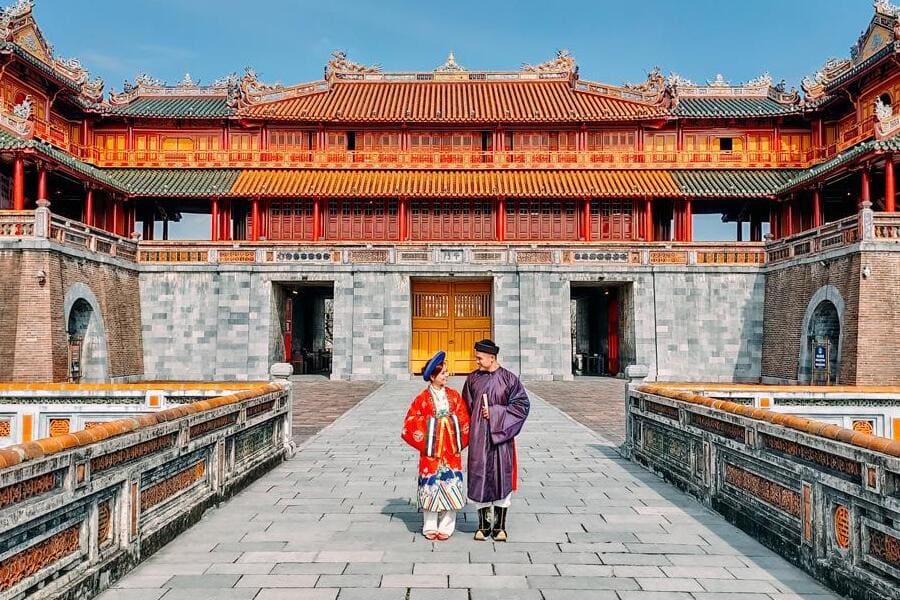Hue Imperial Citadel stands as a testament to the grandeur of the Nguyen Dynasty, reigning for 143 years. Recognized as a UNESCO World Heritage Site, it offers a glimpse into Vietnam’s rich history and cultural heritage. For travelers on Vietnam shore excursions, Hue is an essential stop, where the citadel’s majestic architecture and historical significance await exploration.
An Overview of Hue Imperial Citadel
Hue Imperial Citadel is located north of the Perfume River. It spans across four wards within Hue city: Dong Ba, Tay Loc, Thuan Hoa, and Thuan Loc. To the south, it borders Tran Hung Dao and Le Duan streets; to the north, Tang Bat Ho and Dao Duy Anh streets; to the east, Phan Dang Luu, Huynh Thuc Khang; and to the west, Le Duan street.
When was the Hue Imperial Citadel constructed?
The Hue Imperial Citadel, constructed by the Nguyen Dynasty as their royal capital upon ascending the throne and spanning their reign of 143 years from 1802 until abdication in 1945, is part of the UNESCO World Heritage-listed Complex of Hue Monuments.
How was the Hue Imperial Citadel constructed?
The Hue Imperial Citadel is a monumental construction project that involved tens of thousands of workers and millions of cubic meters of earth and stone. Initially, the citadel was built using earthworks and later fortified with bricks during the reign of Emperor Gia Long. Its architecture blends traditional principles with Eastern philosophies like the Five Elements theory and Western military architecture influences, particularly from Vauban’s style. This synthesis not only resulted in an aesthetically pleasing structure but also imbued it with significant symbolism in terms of Feng Shui and military strategy.
How to get to Hue Imperial Citadel?
To get to the Hue Imperial Citadel, you have a few options depending on your starting point:
- By Taxi: Taxis are readily available throughout Hue city. You can simply hail a taxi and ask to be taken to the Hue Imperial Citadel. Make sure the taxi driver uses the meter or agree on a fare beforehand.
- By Motorbike or Bicycle: Many visitors to Hue choose to explore the city on motorbike or bicycle. You can rent one from various rental shops in the city and ride to the Citadel. It’s a convenient way to navigate through traffic and explore the surrounding areas at your own pace.
- On Foot: If you are staying in central Hue, particularly around the Perfume River area, the Citadel might be within walking distance. It can be a pleasant walk through the streets of Hue to reach the Citadel.
- By Tour or Shuttle: Many hotels and travel agencies in Hue offer guided tours or shuttle services to the Citadel. This can be a convenient option if you prefer a guided experience with transportation included.
- By Public Bus: There are local buses that connect various parts of Hue. You can inquire locally about which bus routes pass by or near the Citadel and hop on accordingly.
The best time to visit Hue Imperial Citadel
The optimal time to visit the Hue Imperial Citadel as Hue shore excursion is during the cooler months of February to April and September to November. During these periods, the weather is generally pleasant with milder temperatures and lower humidity, making it more comfortable for exploring the extensive grounds and historical structures of the Citadel.
Additionally, visiting during these months avoids the peak of the hot and rainy seasons, which occur from May to August, and the cooler but potentially misty weather from December to January. Optimal planning can ensure an enjoyable and comfortable experience while exploring this UNESCO World Heritage Site.
The Architecture of Hue Imperial Citadel
The Hue Imperial Citadel is square-shaped, with a perimeter of 11 kilometers and covers an area of 520 hectares. To acquire such vast land, the kings of old ordered the relocation of eight villages in the area to establish the capital, including Phu Xuan, Van Xuan, Dien Phai, An Van, An Hoa, An My, The Lai, and An Buu. Compensation was provided with new land for rebuilding these villages.
The structure of the Hue Imperial Citadel follows the Vauban-style fortifications of France, featuring 24 bastions protruding outward, combined with Eastern architectural principles.
There are a total of 13 gates, including 10 that open outward, 1 internal gate, and 2 water gates. Among the 10 main gates of the Hue Imperial Citadel are:
- North Main Gate (Hau Gate): located at the rear of the Citadel
- West-NorthGate (An Hoa Gate)
- West Main Gate
- West-South Gate (Huu Gate): to the right of the Citadel
- South Main Gate (Nha Do Gate)
- Quang Duc Gate
- The Nhon Gate (Ngan Gate)
- East-South Gate (Thuong Tu Gate)
- East Main Gate (Dong Ba Gate)
- East-North Gate (Ke Trai Gate)
In addition to these main gates, the Hue Imperial Citadel also includes the Tran Binh Mon Gate and two water gates: Dong Thanh Water Gate and Tay Thanh Water Gate.
The structure of the Hue Imperial Citadel
The Imperial City (Hoang Thanh)
The interior structure of the Hue Imperial Citadel is divided into two main areas: the Imperial City (Hoang Thanh) and the Forbidden Purple City (Tu Cam Thanh), collectively known as Dai Noi Hue. The Imperial City serves as the ceremonial center for important rituals and political activities of the royal court, housing ceremonial palaces. The Forbidden Purple City, on the other hand, is where the king and his close relatives conducted their daily activities and lived.
The Inner Citadel is the second layer within the Hue Imperial Citadel, encompassing a network of palaces and over 100 large and small structures. The Imperial City within it is equipped with four gates on all sides, with the main entrance known as Ngọ Môn located to the south. Here are some notable structures within the Imperial City:
Ngọ Môn
As mentioned, this is the main gate leading into the Imperial City, situated to the south and constructed in the 14th year of Minh Mang’s reign (1834). It hosts ceremonies such as military parades, doctoral conferment (Truyen Lo), and the New Year’s calendar announcement (Ban Soc).
Thai Hoa Palace
This palace, along with its ceremonial courtyard (Dai Trieu Nghi courtyard), serves as the venue for royal ceremonies including coronations, royal birthdays, and receptions for foreign envoys. The king’s golden throne is placed under the canopy inside Thai Hoa Palace.
Royal Shrines and Temples
These are located in front and along the axis of the Inner Citadel. They serve as places of worship for ancestral spirits and the Nguyen dynasty kings.
The Forbidden Purple City (Tu Cam Thanh)
The Forbidden Purple City is located within the Imperial City and represents the innermost area of the Hue Imperial Citadel. Inside the Forbidden Purple City, there are various zones with dozens of architectural structures:
- Dai Cung Mon: The main gate leading into the Forbidden Purple City
- Dien Can Thanh: The residence of the king
- Cung Khon Thai: The residences of queens and concubines
- Duyet Thi Duong: The theater for performing royal court dramas for the king, princes, officials, and foreign envoys
- Thuong Thien: The area for cooking food for the king
- Vien Duong Tam, Thai Binh Lau: Places for the king to rest and read books
- Dien Minh Quang: The residence of princes
- Dien Trinh Minh: The residence of concubines
The structures within the Forbidden Purple City were originally grand with elaborate golden architecture. However, some of these buildings have deteriorated or been destroyed over time, due to natural disasters and wars.
Historical sites
In addition to prominent structures such as the Imperial City and the Forbidden Purple City, the Hue Imperial Citadel encompasses numerous historically significant sites including the Meridian Gate, the National School, Long An Palace, Phu Xuan Palace, Tinh Tam Lake, the Library, Xa Tac Platform, Nine Dynastic Urns, forts,…
What to do at Hue Imperial Citadel?
Learn about Hue’s history
Visit museums and exhibitions within the citadel to delve deeper into the history of the Nguyen Dynasty and Hue’s significance.
Enjoy Royal Court Music (Nhã nhạc)
Visitors can enjoy traditional royal court music performances at the Duyet Thi Duong Hall within the Hue Imperial Citadel. The restored royal theater offers various cultural performances such as court dances, Nhã nhạc music, and excerpts of classical opera, all creatively staged to provide a memorable experience.
Capture Photos in Historical Costumes
A popular experience for many visitors to the Hue Imperial Citadel is dressing up in historical costumes for commemorative photos. The Imperial City area provides services for renting costumes, allowing tourists to transform into emperors, empresses, princes, princesses, or court ladies, adding to the immersive historical ambiance.
Relax in the surroundings
Take a leisurely stroll through the courtyards and gardens to soak in the serene atmosphere.
Hue Imperial Citadel Tour guide
Opening hour
Hue Imperial Citadel opens daily
In summer: 7:30 am – 17:30 pm
In winter: 7:00 am – 17:00 pm
Entrance fee
The entrance fee to visit the Hue Imperial Citadel is now standardized for both foreign visitors and Vietnamese nationals, as follows:
- Adults: 200,000 VND per person per entry
- Children (7 to 12 years old): 40,000 VND per person per entry
Additionally, tourists have the option to select guided tour services at a cost of 150,000 VND per guide.

